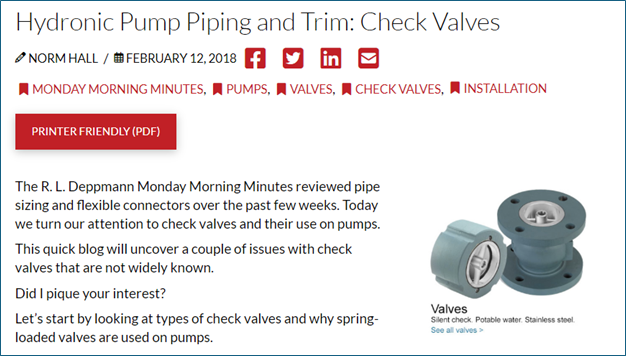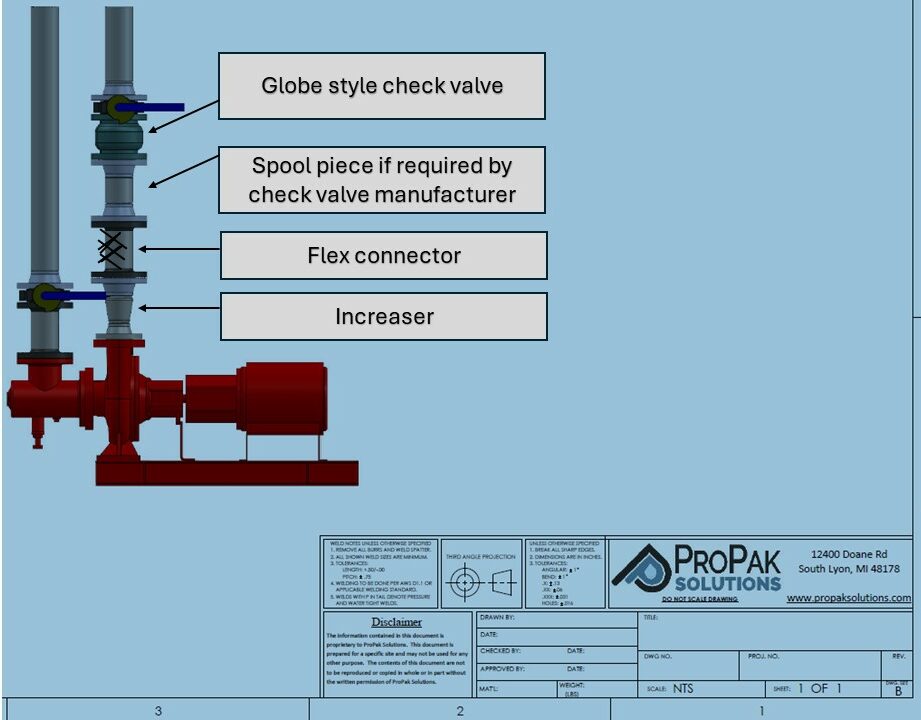Check valves are extensively used on centrifugal pumps in hydronic heating and cooling systems. The technology being used is well over fifty years old. Today, the R. L. Deppmann Monday Morning Minutes looks at types of check valves, their installation and avoiding trouble, their relative cost, and a new energy efficient designed check valve.
Do I Need a Check Valve in My System?
The first obvious question is “do I even need a check valve”? The purpose of a check valve is to prevent water from one pump flowing backwards through another pump. The system will be short of flow if water is bypassed through a pump that is off. In addition, if a pump starts up while the shaft and impeller are spinning backwards, there will be noise and catastrophic damage. You need check valves. Visit an earlier MMM, Hydronic Pump Piping and Trim: Check Valves, for more information. That blog also explains non-slam checks which this article is all about.
Wafer vs. Globe Check Valves
We represent Metraflex and we are often asked by engineers about wafer vs. globe style check valves and which is better? Start with what the difference is between them. Look at the photo from the MMM shown above. The wafer style is on the left and the globe style is on the right. We often describe the wafer as the cream between the cookies in an Oreo cookie. The check valve must be installed between two flanges. More about that below. The wafer style check valve costs less since there is less material and machining to it. The installation of the wafer style will cost more.
There is also an operating cost penalty to the wafer vs. the globe. A wafer check has more pressure drop than a globe style check. For example, a typical 6” wafer check valve may have a Cv of 520 vs a typical globe at 625. This represents an increase in pressure drop of over 40% in the wafer style.
There is even more money to save in a new Metraflex globe style check valve introduced later in this blog post.
Selection and Installation of Check Valves
The check valve is located on the discharge of the pump. There are selection and installation points that both the engineer and contractor should be aware of.
- Most, if not all, manufacturers recommend 5 to 10 pipe diameters upstream of the check valve. It normally shows up in the installation manual. We do not see this on projects very often. The sketch above from ProPak shows the spool piece with a note referring to the manufacturer’s requirements. If the valve is chattering or fails prematurely, the manufacturer will be looking for those pie diameters.
- Most check valve manufacturers have a velocity limitation. If you are using the ASHRAE 90.1 energy standard for pipe sizing, this will meet most requirements. We mentioned this in our Hydronic Centrifugal Pumps – Open & Closed System Discharge Piping blog post.
- All check valves from Metraflex require an ANSI flat face flange and full gasket on the inlet to the check. The video in the Hydronic Pump Piping and Trim: Check Valves blog post addresses this more completely.
- A lug style butterfly valve may be installed directly on a Metraflex globe style valve. The wafer style must have an ANSI flat faced flange on the outlet as well as the inlet.
A Better Design for Globe Style Butterfly Valves
Metraflex has done it again. They took an age-old product and made it more efficient. The Metraflex VFD globe style check has an improved disc design which is more hydrodynamic and reduces the pressure drop. The Metraflex center guided series CVOSSVFD check valve has stainless steel trim, it meets NSF-372, and has a much higher Cv than other valves.
Here is an example of the savings. Let’s look at a 6” pipe at 900 GPM. The new Metraflex VFD globe check has 60% less pressure drop than the 6” wafer check valve and 43% less pressure drop than the traditional globe style check valve. This means your client is saving money every time the pump runs.
Click here for more information or contact your sales engineer at R. L. Deppmann Company.





